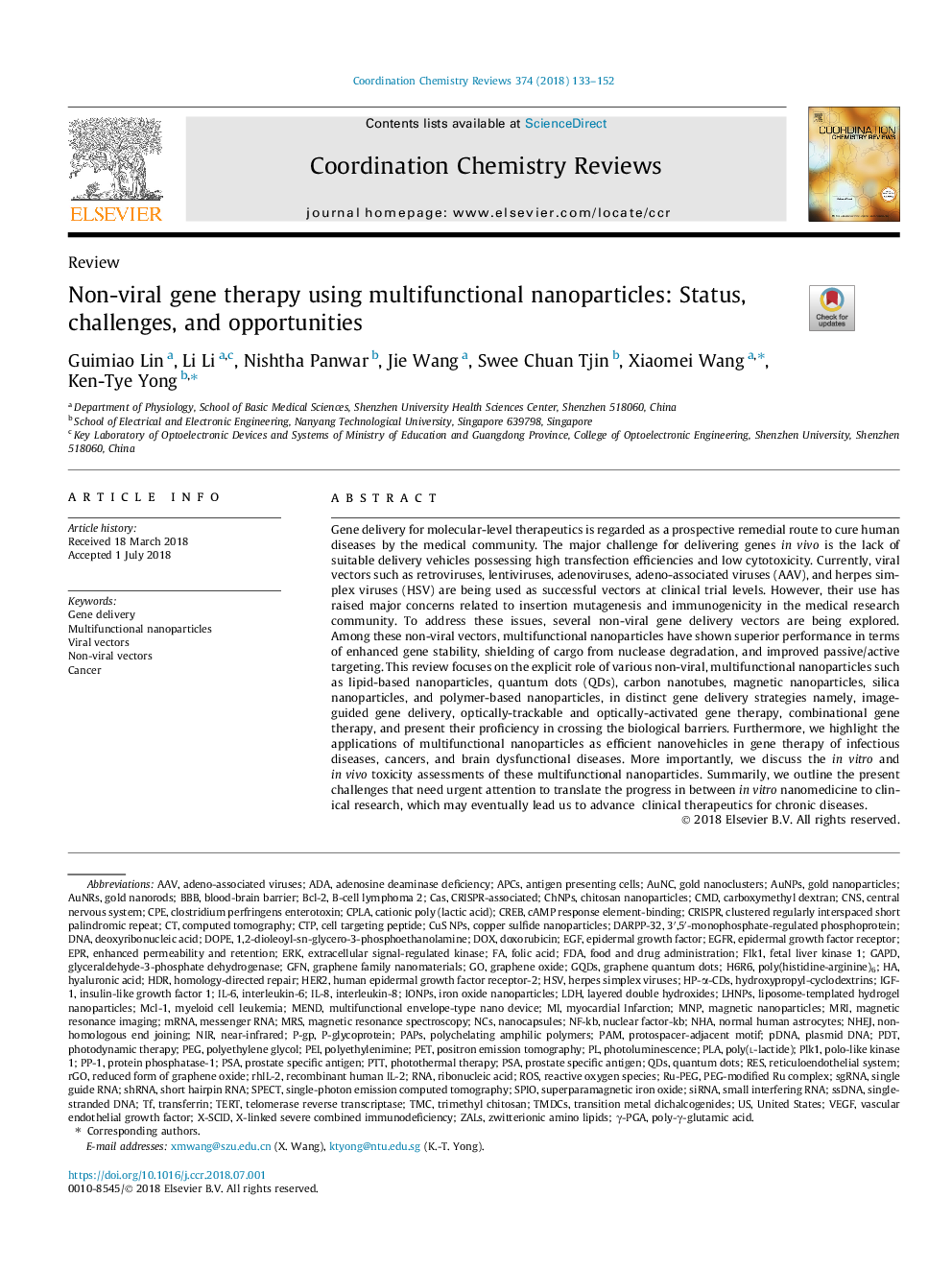| Article ID | Journal | Published Year | Pages | File Type |
|---|---|---|---|---|
| 7747412 | Coordination Chemistry Reviews | 2018 | 20 Pages |
Abstract
Gene delivery for molecular-level therapeutics is regarded as a prospective remedial route to cure human diseases by the medical community. The major challenge for delivering genes in vivo is the lack of suitable delivery vehicles possessing high transfection efficiencies and low cytotoxicity. Currently, viral vectors such as retroviruses, lentiviruses, adenoviruses, adeno-associated viruses (AAV), and herpes simplex viruses (HSV) are being used as successful vectors at clinical trial levels. However, their use has raised major concerns related to insertion mutagenesis and immunogenicity in the medical research community. To address these issues, several non-viral gene delivery vectors are being explored. Among these non-viral vectors, multifunctional nanoparticles have shown superior performance in terms of enhanced gene stability, shielding of cargo from nuclease degradation, and improved passive/active targeting. This review focuses on the explicit role of various non-viral, multifunctional nanoparticles such as lipid-based nanoparticles, quantum dots (QDs), carbon nanotubes, magnetic nanoparticles, silica nanoparticles, and polymer-based nanoparticles, in distinct gene delivery strategies namely, image-guided gene delivery, optically-trackable and optically-activated gene therapy, combinational gene therapy, and present their proficiency in crossing the biological barriers. Furthermore, we highlight the applications of multifunctional nanoparticles as efficient nanovehicles in gene therapy of infectious diseases, cancers, and brain dysfunctional diseases. More importantly, we discuss the in vitro and in vivo toxicity assessments of these multifunctional nanoparticles. Summarily, we outline the present challenges that need urgent attention to translate the progress in between in vitro nanomedicine to clinical research, which may eventually lead us to advance clinical therapeutics for chronic diseases.
Keywords
CREBEGFREGFHER2IL-6CRISPRDOXCPENIRCMDmRNAHDRAPCsNHEJCASNF-kBMcl-1Bcl-2ERKMRSNCSHSVDARPP-32IGF-1AAVIL-8CTPGAPDP-gpCRISPR-associatedMNPIONPsGFNmyeloid cell leukemiaGQDsFLK1FDAcPLAAuNRs1,2-dioleoyl-sn-glycero-3-phosphoethanolamineAuNPsDNAnHAP-glycoproteinPAPsmessenger RNAAntigen presenting cellsMyocardial infarctiondeoxyribonucleic acidFolic acidHyaluronic acidHomology-directed repaircAMP response element-bindingMRIClostridium perfringens enterotoxinGraphene oxideInterleukin-8interleukin-6clustered regularly interspaced short palindromic repeatEPRMagnetic resonance imagingcomputed tomographyCNSmultifunctional envelope-type nano deviceDoxorubicinFood and Drug AdministrationBBBcentral nervous systemmagnetic resonance spectroscopyNormal Human astrocytesepidermal growth factornon-homologous end joininginsulin-like growth factor 1Nuclear factor-kBLDHB-cell lymphoma 2Blood-brain barrierMENDIron oxide nanoparticlesCopper sulfide nanoparticlesGold nanorodsGold nanoparticlesMagnetic nanoparticlesChitosan nanoparticlesNanocapsulesGold nanoclustersNear-infraredEnhanced permeability and retentionGraphene quantum dotsLayered double hydroxidesADAAdeno-associated virusesHerpes simplex virusesDOPEcarboxymethyl dextranadenosine deaminase deficiencyextracellular signal-regulated kinasefetal liver kinase 1glyceraldehyde-3-phosphate dehydrogenaseEpidermal growth factor receptorHuman epidermal growth factor receptor-2
Related Topics
Physical Sciences and Engineering
Chemistry
Inorganic Chemistry
Authors
Guimiao Lin, Li Li, Nishtha Panwar, Jie Wang, Swee Chuan Tjin, Xiaomei Wang, Ken-Tye Yong,
